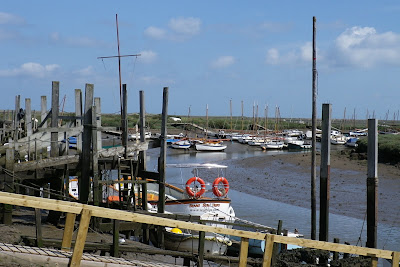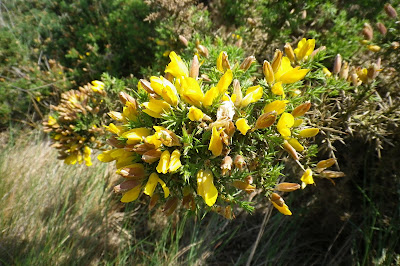The tide was way out so the boats were all high and dry in the creek. It also meant that there were few people about - boat trips leave from here at high water. Redshanks and Oystercatchers flew up noisily on all sides and may have had nests in the vicinity so I was careful where I trod.
Little pink flowers of Thrift added a sprinkle of colour to the scene. They are also known as Sea Pinks, which makes sense since they are pink and grow by the sea, but why "Thrift"? Apparently the words "thrift" meaning "careful with one's resources", "thrive" meaning "to flourish" and the name of the plant, all derive from the Old Norse word thrifask which means "to grasp for oneself" and by implication to do well in difficult circumstances. This the little plant certainly does, thriving on windswept clifftops, on poor soil, on salty land and even on spoil heaps from lead mines. This last adaptation gave rise to to the idea that it was a cure for lead-poisoning. Incidentally, readers who are old enough and English enough will remember that the flower used to be depicted on the old threepenny-bit; a pun on the word "thrift" and also perhaps acknowledging its ability to thrive on the cheap metals from which the coin was made.
Further on I encountered gorse bushes in flower which reminded me of the old saying "When gorse is flowering then kissing's in season" - a happy thought since gorse seems to flower throughout the year!
At Stiffkey Fen a number of birds were either nesting or caring for young ones. The nearby house always looks an idyllic place to live in summer but less so in mid-winter when gales blow in from the North Sea and huge flocks of noisy geese inhabit the fen. I wandered on in the warm sunshine to Wells-Next-The-Sea, of which more in future posts, then caught the bus to the RSPB reserve at Titchwell Marsh .
Lots of changes have been taking place at Titchwell as it has been realised that maintaining the sea defences in their present position is going to prove prohibitively expensive. The RSPB have taken the opportunity to re-vamp the whole site, in particular building a new Parrinder Hide.
Having seen it I really don't know what to make of it: it's certainly a fine building, impressive, functional and comfortable; but as yet it seems to look completely out of place and doesn't fit in with my feeling that birdwatching is just one aspect of the outdoor experience. As you sit on the swivelling stools and peer out through the panoramic windows you almost feel that you might as well be watching Springwatch on TV. Which reminds me..
Take care.








Thanks John, for the lovely tour. I really enjoy the places you take us to visit, and the stories behind each place we go!!!
ReplyDeleteLovely photo of Stiffkey Fen, it looks beautiful which is more than can be said for the RSPB hide. I really don't like that,it looks completely out of place, I always thought that hides were supposed to be inconspicuous and blend in with the landscape!
ReplyDeleteI've never seen an avocet so that's another good reason to visit the north Norfolk coast:)
The pleasure was all mine, Liz.
ReplyDeleteYou can see Avocets from the new hide if that counts as a redeeming feature, Rowan. I suspect that on a freezing mid-winter day it may have other attractions too, but I tend to agree - a hide should look more like a garden shed.